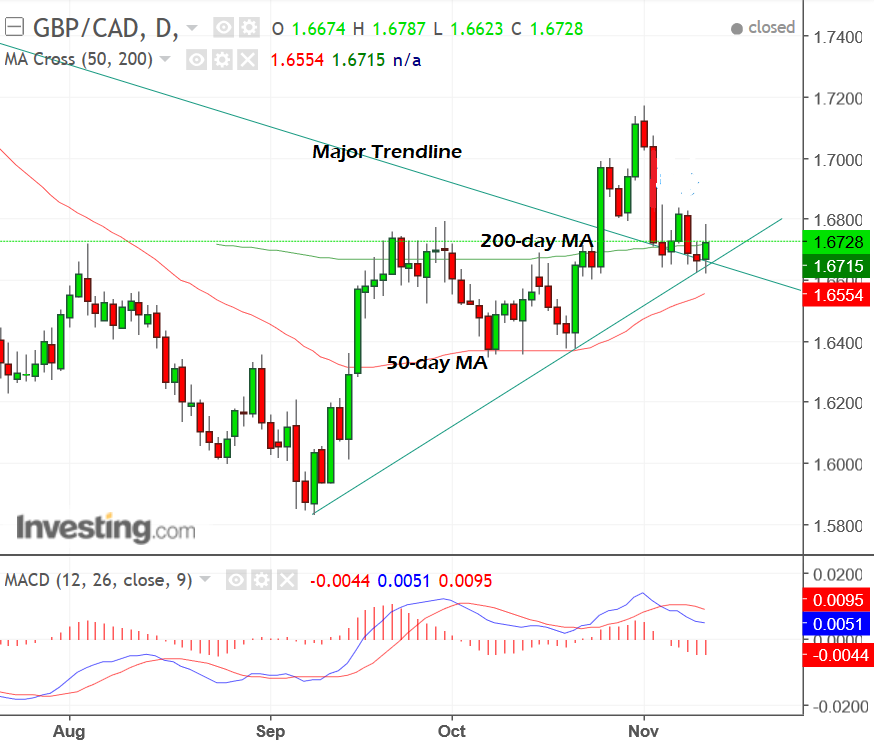Pound-to-Canadian Dollar Rate Week Ahead: Technical Forecast, Events and Data to Watch

GBP/CAD has fallen back recently but analysts think this may just be a temporary pull-back before the pair resumes its short-term uptrend.
The Pound-to-Canadian Dollar exchange rate has broken above a major downward-sloping trendline that has been in place for months now and suggests perhaps a significant turn in trend is underway.
The exchange rate has moved higher temporarily but then fallen back down again over the last eight days.
At the time of writing the pair is quoted at 1.6638, having gone as high as 1.7165 earlier this month.
Concerning the immediate outlook; on the one hand, we have the very bullish break above the trendline, but then the follow-through higher has been extremely disappointing which raises questions on the exchange rate's ability to push higher from here:

Sometimes charts can provide us with clues as to the future trajectory of price action but looking at the setup on the GBP/CAD at present I find it difficult to see any near-term clues and would advocate waiting for further evidence before making a decision.
Technical strategist Shaun Osborne at Scotiabank is however notably more bullish on the exchange rate. Of the pull-back, seen this November he says:
"This goes a little further in setting up the bullish inverse H&S signal we have noted might be forming for the GBP (bullish above 1.68 at this point). Recall that the GBP’s medium-to-longer run outlook is constructive from a technical perspective, following the bullish key month reversal that developed in Sep. Monitor for now but we look for opportunities to buy GBP weakness."
So while near-term direction looks cloudy, the broader trend for those who can afford to wait still appears to be largely positive.
Get up to 5% more foreign exchange by using a specialist provider by getting closer to the real market rate and avoid the gaping spreads charged by your bank for international payments. Learn more here.
Data and Events to Watch for the Canadian Dollar
The main event for the Canadian Dollar in the week ahead will be the release of Inflation data for the month of October on Friday at 13.30 GMT.
Inflation feeds into central bank policy, and central banks set interest rates depending on inflationary pressures.
Higher interest rates, in turn, tend to support the currency by attracting greater flows of foreign capital due to the higher interest returns on offer.
Current market expectations are for a 1.4% rise in inflation compared to the 1.6% of October 2016.
Economists estimate a 0.1% rise on a monthly basis compared to the 0.2% rise in September.
A higher-than-expected inflation print is likely to push up the Canadian Dollar and GBP/CAD down.
Data and Events for the British Pound
Political factors will remain a key focus in the coming week.
They will probably revolve around two major issues: the first is the survival of the Prime Minister and the second the passage of the 'withdrawing bill' through parliament, which is the piece of legislation which will take the UK out of the EU.
The latest reports suggest that the number of rebel Tory MP's who want Theresa May to quit the party leadership has grown to 40 which is only 8 short of the number needed to trigger a leadership challenge.
If a mutiny emerges in the week ahead, it will destabilise the political and economic outlook and likely weigh heavily on the Pound - the Pound dislikes uncertainty and questions over the UK's political direction would weigh heavily, particularly as the prospect of an anti-market Labour party Government taking power becomes more likely.
Instability in the UK Government also of course has impacts on the UK's ability to negotiate on Brexit which remains critical to the Pound's outlook.
A change of leadership in the Conservative party would surely delay Brexit negotiations, while another general election would certaintly knock months of the timeline.
The other great issue is the 'withdrawal bill' which passes through Parliament this week. MP's will be debating final amendments to the bill - which provides the domestic legislation required to take the UK out of th EU - in the coming week.
One major point of contention is whether the bill should be changed to allow MP's a vote on the final Brexit deal negotiated with the EU. A number of Conservative MPs are expected to vote with Labour to force through changes to the bill, or at the very least block passage of the bill.
If this is indeed the case then the Government's fragile majority in the Houses of Parliament will be exposed, once again drawing questions over the Government's longevity.
Hard Data to Watch in the UK
The main release in the coming week is inflation data on Tuesday, November 14, at 09.30 GMT, with October expected to see a rise of 3.1% compared to a year ago, which would represent a rise of 0.1% from the previous 3.0% result and see inflation hitting a new 2017 peak.
Such a rise in inflation would probably be marginally supportive of the Pound as it would increase in the chance the Bank of England (BOE) will raise interest rates again, perhaps even sooner than previously expected.
Nevertheless, the BOE themselves have forecast inflation peaking at 3.1% in October - but then rolling over - so it would take a sustained rise for several months to really support the Pound - or a shock rise in October of over the 3.1% expectation.
Higher interest rates strengthen currencies because they attract more inflows of foreign capital from global investors drawn by the promise of higher interest returns - and vice-versa with lower interest rates.
Central banks control the base interest rate which all other banks use to set their interest rates.
When inflation is too high central banks raise interest rates to bring prices back down by encouraging saving over spending and discouraging borrowing by making it more expensive.
Another major release for the Pound over the next five days is employment data on Wednesday at 9.30 GMT.
The main focus will not be on the Unemployment rate, however, unless it is widely divergent from estimates, but rather on wage data.
This is because earnings are directly linked to inflation with a pick up in the former leading to a rise in the later.
Therefore a strong pick-up in earnings (Ex-bonus) which were 2.2% previously and are expected to moderate down to 2.1% would help Sterling, and vice-versa for a fall.
The final major release of the Pound is Retail Sales data on Thursday at 9.30.
On a monthly basis Retail Sales both Core is expected to rise from very depressed readings in September of -0.7% and -0.8% respectively, rising to 0.1% for both.
Compared to October last year, however - ie year-on-year - they are forecast to show a -0.4% fall for Core and -0.7% for headline compared to 1.6% and 1.2% respectively in October 2016.
The data is significant for the Pound because a further contraction in Retail Sales will increase concerns about growth and mean it is less likely the BOE will put up interest rates, resulting in weakness for Sterling.




